For the Record. Thoughts on Medium Specificity in the Sonic Arts
In contrast to the debates in the visual arts centred around new image-making technologies such as photography and film in the first half of the 20th century, consideration of technical storage media was widely neglected by musicologists in the same period. However, when it comes to technical transmission and storage media for audio such as phonography, radio, electromagnetic tape, compact discs and audio streaming, etc., the question of medium specificity opens up interesting theoretical perspectives.
A mainly Germanophone discourse emerging in the late 1990s and early 2000s coined the term Medienmusik (media music), understood as musical medium specificity (Großmann 1997; Straebel 2009, 2012 and 2014). These discussions not only established a theoretical analysis of the implications of technical audio media for the making of music, but also led to extensive case studies on the topic.
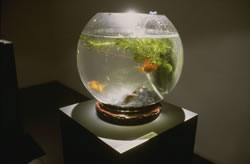
A sound-based, medium-specific practice can be understood as a critical, media-æsthetic interrogation of audio recording and transmission. Far from being simply an extra-musical tool for the preservation of music, technical media are understood as catalysts for musical thinking and innovation. Medium specificity in music and sound art thus insists on the fact that the materiality of recording and playback media matters and continues to shape artistic practice. Since the mid-2000s, analyses in the fields of musicology and sound studies have been published internationally, covering the history of medium-specific practices ranging from Paul Hindemith and Ernst Toch’s gramophone-specific music (1930) to the strips of magnetic tape in Nam June Paik’s Random Access (1963) to the glitching and skipping compact discs of Yasuano Tone (1984) 1[1. Nicolas Collins speaks of Tone’s influence on his own early practices of “Hacking the CD Player,” also in this issue of eContact!] or Oval (1993) and eventually to Kim Cascone’s “‘Post-Digital’ Tendencies in Contemporary Computer Music” (2000) [Katz 2004; Kelly 2009].
This said, just how far the notion of medium specificity is implicitly based on essentialist and normative ideas presupposing that media possess fixed, essential properties dictating the modes of their use has been widely discussed. Although these debates stem primarily from visual arts discourse, they can nevertheless enrich the theorizing of medium-specific practices.
Medium Specificity in Æsthetic Discourse
Arguments around the idea of medium specificity can be traced back — avant la lettre — to 18th-century debates within Western art theories. Some theorists in France, England and Germany saw mimesis as the common principle of all arts — Charles Batteux’s 1746 treatise The Fine Arts Reduced to a Single Principle may serve as an example. Others were beginning to express doubts as to the validity of this concept. In his theoretical pamphlet Laocoon: An essay on the limits of painting and poetry (1898), Gotthold Ephraim Lessing argued not only against the premise that there exists a single principle in art but also for categorical distinctions between synchronous modes of articulation (plastic arts, painting) and diachronous modes (literature, theatre, music).
Lessing’s plea for a distinction between art forms was taken up by Clement Greenberg in his essays “Avant-Garde and Kitsch” (1939, in Greenberg 1961) and “Towards a Newer Laocoon” (1940). The influential theory of Greenbergian modernism coined the concept of medium specificity. While Lessing‘s terminology was centred around the notion of art forms, Greenberg in 1960 famously introduced the idea of a unique medium possessed by each art form.
Each art had to determine, through its own operations and works, the effects exclusive to itself. By doing so it would, to be sure, narrow its area of competence, but at the same time it would make its possession of that area all the more certain.
It quickly emerged that the unique and proper area of competence of each art coincided with all that was unique in the nature of its medium. The task of self-criticism became to eliminate from the specific effects of each art any and every effect that might conceivably be borrowed from or by the medium of any other art. Thus would each art be rendered “pure,” and in its “purity” find the guarantee of its standards of quality as well as of its independence. (In Greenberg 1993, 86)
For Greenberg, a source of æsthetic value in terms of a guarantee of standards was to be found in the substrate of an artistic medium and in certain conditions derived from it — in painting: flatness and opticality (Greenberg 1940, 1961). Greenberg’s concept of medium specificity demands truth to these conditioning material properties — painting should exemplify the properties of its medium. But, as one of Greenberg’s critics, Noël Carroll, pointed out, “painting was not invented to celebrate flatness” and, further, “the idea of the artist discovering new ways of using the medium would make no sense if the medium were designed for a single, fixed purpose” (Carroll 1996, 32). A medium-essentialist position claiming “that each art form possesses a unique medium that has productive implications about what should and should not be made in it” (Ibid., 1) raises some issues. How can there be a final consensus about the essential properties as long as different theorists will identify different potentials of that medium? (Ibid., 3) Also, the medium essentialist fails to acknowledge intermediality in the arts, i.e. the media interactions, combinatorial practices, remediations and transformations already prevalent in the artworks of Greenberg’s contemporaries (notably John Cage, Robert Rauschenberg and Fluxus — artists and practices with which he was, of course, quite familiar), not to mention its presence in today’s ubiquitous digital intermedia formats.
It does not come as a surprise that Greenberg’s normative pull on what is suitable to do with a medium has been widely criticized, because it entails a narrow fixation of essentials. Greenbergian theory implies the
notion that modernism in the arts involved a process of reduction… until in the end one arrived at a kind of timeless, irreducible core (in painting, flatness and the delimitation of flatness). The implication of this account was that such a core had been the essence of painting all along, a view that seemed to me ahistorical. (Fried 1987, 57)
Rosalind Krauss also distanced herself from Greenberg’s position by defining media as changeable and differing structures, arguing that medium specificity is neither to be found in a rigid set of essential features nor can it ever be completed or exhausted. Instead, she regards medium specificity as a set of rules and conventions derived from (but irreducible to) the given physical materiality of a medium:
The specificity of mediums, even modernist ones, must be understood as differential, self-differing, and thus as a layering of conventions never simply collapsed into the physicality of their support. (Krauss 1999b, 53)
Krauss’ critique was highly influential in opposing the fixity of Greenberg’s notion of the medium (see Houwen 2017). She challenged medium essentialism with her non-reductive account and with what she thinks of as differential specificity. Krauss also explicitly addressed the role of technical media in the arts by introducing the idea of a technical support, which she considers to be more flexible and less restrictive than Greenberg’s view on medium: a technical support remains open to and even encourages artistic repurposing. Artists who discover and explore the rules or conventions of a technical support, she claims, can be said to “invent” a new medium (Krauss 2011, 18ff).
This claim stands in stark contrast to Greenberg’s essentialist assertion that a medium’s material properties dictate its proper artistic usage. Unfortunately, Krauss does not provide further clarification on the relation between the layering of conventions and the physicality of technical supports. At the same time, this relation seems to be at the core of medium specificity, thus it would be advisable to discuss it in greater detail. The concept of “affordance”, originally developed in ecological psychology, offers a perspective for negotiating this relation between a set of possible actions and the materiality of technical supports.
Affordances of Technical Media in the Sonic Arts: Expanded Phonographs
In science and technology studies, as well as in more recent accounts of media ecology, media anthropology and communication studies, the affordance perspective has been increasingly mobilized to address the complex entanglement of media-technical objects or environments and human agents. The term “affordance” was coined by ecological psychologist James Gibson in order to explain how agents (human or otherwise) take action based on perceptions of the utility of components of their environment (Gibson 1979).
You couldn’t be a passive listener, you had to be involved.
—Christian Marclay
For Gibson, affordances refer to action possibilities or potentials available in an object. These potentials are relative to the action capabilities of an agent. Pertinent examples in natural environments are caves, which afford shelter, or technical artifacts such as doorknobs, which afford the opening of doors. However, an affordance may exist independently from the agent actualizing or even recognizing it. At the same time, “any affordance is only actualized when it is acted upon. […] Affordances thus exist independently of human intention but can nevertheless not materialize without them” (Scarlett and Zielinger 2019, 9). According to Gibson, affordances are actionable properties between the world and an actor that have, in certain cases, become conventional; in other cases they remain to be discovered. Building on ecological terminology, he calls these sets of undiscovered and not-yet occupied affordances niches (Gibson 1979, 128).
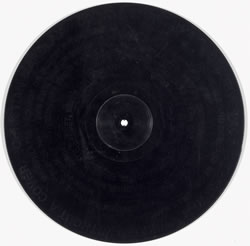
In design and human-computer interaction research, Gibson’s affordance perspective was popularized by Don Norman (1988). However, applying a user-centred focus, Norman assumed that affordances provide strong clues about the functioning of things and can be built into an object by design. “Where Gibson’s perspective was meant to open up our understanding of the relational ontology of objects and environments, of their uses and purposes, and the limits thereof in relation to human agents, Norman’s view narrows this ever-widening and potentially open-ended horizon” (Scarlett and Zielinger 2019, 11). Norman suggests that affordances can be designed and fixed independently from constellations of environment/object and agent.
Even if “it is tempting to apply technology-specific feature orientation rather than the connection between objects — in coordination with human goals — and outcomes” (Evans et al. 2017, 39), it is critical to recognize that Gibsonian affordances have never been theorized as stable or object-inherent (Nagy and Neff 2015, 3). On the contrary, Gibson’s line of thought led to the conclusion that affordances should be conceived as relational dynamic entities embedded in the interactions of agents with technical objects. This is precisely the reason why the concept of technological affordance is attractive in the context of medium specificity — it offers an approach beyond essentialist reduction and fixation. Affordances emerge through interaction (experimentation, adaption) of users with technical objects. In this view, the materiality of technical objects influences but does not determine schemes of action. The affordance perspective suggests that neither techno-determinism nor social constructivism is sufficient to explain the multifaceted use of technical objects (Evans et al. 2017). Thus, in line with Krauss’ notion of differential specificity, an affordance perspective might offer a broader framework for approaching medium-specific practices in the sonic arts than modernist æsthetic reductionism.
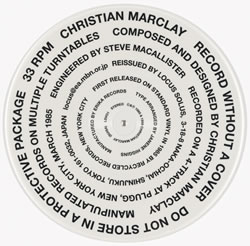
Christian Marclay’s Record Without a Cover from 1985 is a well-known example for an æsthetic appropriation of a reproduction medium in foregrounding the performative aspects of playback. Record Without a Cover was sold without any protective package and, furthermore, one of the record’s sides is printed with the instruction “do not store in a protective package” (Figs. 2–3). The other playable side of the album contains one single and untitled track. The beginning section of this track contains recorded scratches of other vinyl records, which slowly grow louder before leading into jazz drum samples and fragments of recorded music — Caravan by Duke Ellington is a clearly recognizable sample amongst various other recorded, looped, scratched and manipulated sound snippets from electroacoustic and orchestral recordings.
By issuing the record without a cover and instructing the buyer to not protect the vinyl, Marclay virtually guarantees that the record will quickly accumulate marks and scratches caused by its inevitable handling. Whereas the convention demands that the user protect the record’s “sensitive” surface as much as possible, Marclay’s record explicitly requests the opposite:
It was a record that threatened everything you were taught about records and how to handle them. It even threatened your needle. You couldn’t be a passive listener, you had to be involved. It was intriguing, unstable. It was a record about records. (Marclay and Tone 2004, 346)
Marclay’s record affords an alternative scheme of action to conventional vinyl playback that allows and in fact ensures the record will accumulate traces of interaction with its environment. Not only will the surface of the vinyl have accumulated different scratches every time it is played back, but its copies also turn into unique artifacts. What began as mass-produced and virtually identical objects would slowly diverge from one another, becoming singular, yet ever-changing works. “Recorded sound is dead sound, in the sense that it’s not ‘live’ anymore.” As Marclay himself says:
Record Without A Cover was about allowing the medium to come through, making a record that was not a document of a performance but a record that could change with time, and would be different from one copy to the next. (Cited in Young 2005).
Obviously, this is a process that no record can escape, but we have developed perceptual techniques in order to differentiate between “undesired” aural artifacts and meaningful sound. In contrast, Marclay conceptually highlights the record’s deterioration by drawing attention to it: “You can’t ignore that you are listening to a recording.” And by printing the aforementioned set of instructions on the medium itself, he turns handling and playback into a performance.
Another example conceived in the same year is Roger Miller’s POP Record / Evolving. On the surface of the B side of this record, Miller used a screwdriver to inscribe the first three measures and the final measure from the fugue of Bach’s Prelude and Fugue in G minor BWV 861 (Fig. 4) directly into the vinyl — in lieu of conventional vinyl grooves. Side A features a recording he had made in 1985 2[2. In December 1985 one single copy was issued as Fun World Product 003. The disc was re-released — with the Side B etching — in December 1998 by RRRecords (RRR-104).] for the project that consists entirely of noises and scratches sourced from the between-track “silence” gaps of pop records by artists ranging from James Brown and Billy Holiday to Xenakis to Black Sabbath to an unidentified sci-fi record from Japan. Each time the disc is played, the recorded noises and scratches are accompanied by sounds produced by the needle encountering new actual scratches on the record’s surface — the record is thus constantly evolving and regenerating itself (Miller 2019).
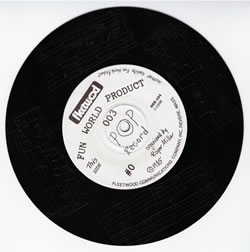
Both Marclay and Miller’s records strategically blur the difference between artifacts of mediation and their pre-recorded doubles. Intended and non-intended scratches will eventually coexist as a palimpsest, creating an ambiguous soundtrack: “There is confusion between what’s intentionally recorded and what is damage on the surface of the disc” (Snow and Marclay 2007, 129). It is precisely the confusion and ambiguity that makes their records stand out. Using techniques of remediation (the re-recording of the records’ scratches and noises), they provoke a shift in perspective back and forth between opacity and transparency, the intended and the unintended, the listened for and the listened away from, signal and noise.
Paul DeMarinis discussed surface noise with reference to a series of works he developed between 1989 and 1996 that comprise The Edison Effect:
[T]he sound of the recording apparatus itself… presented both a subtler set of problems and a new and paradoxical sort of territory of its own. The rumblings of the mechanism, too, register upon the wax, and the texture and grain of the wax has its own raspy voice, a voice that sang along with every diva and accompanied every chance sound passing by the microphone. Surface noise, channel noise, the song of long ago and far away, presented a gift in disguise to the recordist and artist alike. This noise is an audible indication that information is being sent. In effect this “noise-floor” is the sound of silence of any given channel. (DeMarinis 1997, 1)
On another occasion he emphasized that:
Unlike the environmental sounds, these sounds would not exist if the recording had not been made. I call this the shadow of the technology, and it is this shadow world that I examine in The Edison Effect. (Shiba 1997, 4)
In The Edison Effect, phonographic cylinders, 78 rpm records and gelatin dichromate holograms of such records are scanned with laser beams and photoelectric sensors (Video 1). This series of works extends the notion of touch associated with the needle that follows the groove of a record and produces a sound:
The central image in The Edison Effect is of the fusion, or conflation of looking and listening. The beam of a laser for me is much like the visual ray that was, in ancient times, believed to emit from the eye permitting the viewer to see by touching with his eyes.” (Shiba 1997, 4)
Within this framework of media-archaeological reconfigurations, each work reflects the varying affordances of sound inscription and playback from a different point of view. DeMarinis links narratives derived from the recordings (Wagner’s Liebestod to Strauss’ Blue Danube Waltz) with different technical manipulations. In the case of Al and Mary Do the Waltz (1989), a laser beam scans an Edison wax cylinder of the Blue Danube Waltz spinning on a paint roller (Fig. 5). 3[3. The title symbolizes Thomas Alva (Al) Edison and the protagonist of the poem “Mary Had a Little Lamb,” which Edison himself recited into his phonograph to create the world’s first sound recording.] The beam traverses a fishbowl containing two live goldfish (Fig. 1) that occasionally interrupt the laser and “produce uncomposed musical pauses” (DeMarinis cited in Beirer et al. 2010, 129).
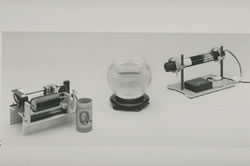
In The Edison Effect, Paul DeMarinis reconfigures the phonograph and alters the constraints we usually associate with this apparatus. The record is expanded as a medium:
The arrangement of optics, motors and light allow random access to the grooves of the record, permitting distortion, dis-arrangement and de-composition of the musical material. (DeMarinis cited in Beirer et. al 2010, 127)
Yet different reconfigurations of the medium have been carried out in the digital domain of artistic data sonification. Digital technologies certainly have their own physical materialities and affordances, but they may at the same time model formal, quasi-material structures:
The affordances of the digital are not only shaped by the “forensic” materials that undergird digital technologies, rendering them operable, graspable, and interactable, but [can also be] grounded within the iterative, ephemeral and seemingly “dematerialized” structures of formal regimens. (Scarlett and Zielinger 2019, 19)
Not only hardware, but also dematerialized structures — such as algorithms understood as digital objects — can actualize affordances in relation to the user.
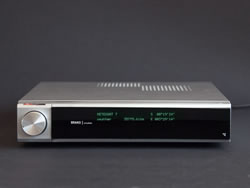
Jens Brand’s Global Player (usually stylized as G-Player) from 2004 is a device based on data sonification algorithms. It functions like a record player, but instead of vinyl LPs it scans the surface of the Earth using a virtual needle. The G-Player is able to locate the positions of officially known satellites. Its sound is generated in real time following satellite orbits matched against a topographical database of the Earth. Following the formal regiment of a phonographic needle, the satellite scans the surface of the Earth, and translates the topography into sound as if it were following the grooves of a vinyl LP. Using digital modelling, the phonographic structure can be scaled up to cosmic dimensions. The display on Brand’s G-Player shows the name and type of the selected satellite (military, weather or telecommunication, etc.), its altitude and the coordinates of its orbit on Earth (longitude and latitude). Satellites probe the surface of the Earth in the same way a needle would follow the groove of a record. But in contrast to a phonographic trace, the Earth’s surface has never been encoded and therefore Brand’s sonification device receives a “signal” that has never been sent. It is the subtext of this work that alters the sonic experience of meaningless noise. It is not the sound itself, but Brand’s meticulous artistic framing which makes us believe that we’re “listening to the earth”.
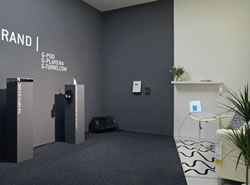
Inspired by Apple’s branding of consumer electronics, Brand staged the launch of his “product” dressed as a salesman in a slick, corporate-looking trade fair booth equipped with IKEA furniture (still bearing their price tags) and indoor plants (Fig. 7). Rosalind Krauss, who associates medium-specific strategies with a withdrawal of the technical support from mass culture, emphasizes the potential of artistic practice to re-articulate “outmoded, low-tech support[s]” (Krauss 1999a, 301). She regards them as being freed from their intended function as devices to stimulate consumption. Outmoded technologies make it possible to grasp the inner complexity of the media they support and can thus be utilized to demonstrate a site of resistance: “[O]bsolescence, the very law of commodity production, both frees the outmoded object from the grip of utility and reveals the hollow promise of that law” (Krauss 1999b, 41). Whereas Krauss favours the medium specificity related to outmoded technical supports, Brand’s work demonstrates medium specificity as an ironic caricature of present-day technical supports and their promises of usability and usefulness. Everything about the G-Player carries the imprint of an industrially produced commodity, thus commenting on technological capitalism and fashionable commodified blackboxing. Brand’s project mimics corporate identities and state-of-the-art technology in order to circulate a more than outmoded myth: the earth is a disc.
Conclusion
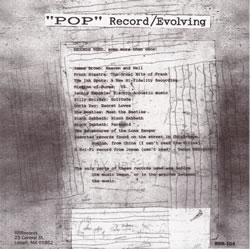
The artistic works described here have shown different ways of reflecting the medium specificities of phonography. However, it is not merely the features tied to the objects in use, which are reflected in the works, but rather their affordances: the relational link between technical object, artistic use and outcome. Christian Marclay and Roger Miller use remediation strategies in order to produce a record about records. Paul DeMarinis uses optical extensions for the scanning of phonograph records inspired by the ancient concept of tactile vision, resulting in a performative intervention of animal agents and uncomposed musical events. Jens Brand uses digital data sonification resulting in a quasi-phonographic playback of the earth’s surface.
Each of these works may be considered to be medium-specific, but not in the sense that they reveal or display certain properties of their technical support. In fact, Greenbergian purism would be misguided in view of the inherent diversity encountered in extended media assemblages. A reductionist viewpoint would not be able to address the complexity of media-technical (re-)configurations in the arts and would necessitate ignoring the reflexive layers that medium-specific practices may introduce. Instead, a differential and relational perspective might help to further shape and outline a concept of medium specificity that is not only historically informed but also aware of its theoretical shortcomings.
Bibliography
Beirer, Ingrid, Carsten Seiffarth and Sabine Himmelsbach (Eds.). Paul DeMarinis: Buried in noise. Heidelberg / Berlin: Kehrer Verlag, 2010.
Brand, Jens. G-Player (2004). [Mixed Media Installation] http://www.jensbrand.com/gplayer_images.html [Accessed 29 December 2019]
Carroll, Noël. Theorizing the Moving Image. Cambridge MA: Cambridge University Press, 1996.
DeMarinis, Paul. Artist talk delivered at ICAD 1997. The Fourth International Conference on Auditory Display (Palo Alto CA, USA, 3 November 1997). Available at http://pauldemarinis.org/texts/OldWellWritings/ICAD1997.docx [Accessed 29 December 2019]
Evans, Sandra K., Katy E. Pearce, Jessica Vitak and Jeffrey W. Treem. “Explicating Affordances: A Conceptual framework for understanding affordances in communication research.” Journal of Computer-Mediated Communication 22/1 (January 2017), pp. 35–52. http://doi.org/10.1111/jcc4.12180 [Accessed 29 December 2019]
Fried, Michael. “Theories of Art after Minimalism and Pop.“ In Discussions in Contemporary Culture. Edited by Hal Foster. Seattle WA: Bay Press, 1987, pp. 56–57.
Gibson, James J. The Ecological Approach to Visual Perception. Boston MA: Houghton Mifflin, 1979.
Greenberg, Clement. “Towards a Newer Laocoon.” Partisan Review 7 (July–August 1940), pp. 296–310.
_____. “The New Sculpture.” In Art and Culture. Critical Essays. Boston MA: Beacon Press, 1961, pp. 139–145.
_____. “Modernist Painting” [1960]. In Clement Greenberg: The Collected Essays and Criticism. Vol. 4: Modernism with a Vengeance, 1957–1969. Edited by John O’Brian. Chicago IL / London: The University of Chicago Press, 1993, pp. 85–93.
Großmann, Rolf. “Konstruktiv(istisch)e Gedanken zur ‘Medienmusik’.” In Medien — Musik — Mensch: Neue Medien und Musikwissenschaft. Edited by Thomas Hemker and Daniel Müllensiefen. Hamburg: von Bockel, 1997, pp. 61–78.
_____. “Klang — Medium — Material. Über den technikkulturellen Wandel des Materials auditiver Gestaltung.” In Sonambiente 2006: Klang-Kunst, Sound art. Edited by Helga de la Motte-Haber, Matthias Osterwold and Georg Weckwerth. Berlin: Kehrer, 2006, pp. 310–319.
Houwen, Janna. Film and Video Intermediality: The question of medium specificity in contemporary moving images. New York/London: Bloomsbury Academic, 2017.
Katz, Mark. Capturing Sound: How technology has changed music. Berkeley CA: University of California Press [2004], revised edition 2010.
Kelly, Caleb. Cracked Media: The sound of malfunction. Cambridge MA: The MIT Press, 2009.
Krauss, Rosalind E. “’Reinventing the Medium.” Critical Inquiry 25/2 (Winter 1999) “Angelus Novus”: Perspectives on Walter Benjamin, pp. 289–305. http://jstor.org/stable/1344204 [Accessed 29 December 2019]
_____. A Voyage on the North Sea: Art in the age of the post-medium condition. New York NY: Thames and Hudson, 1999.
_____. Under Blue Cup. Cambridge MA: The MIT Press, 2011.
Lessing, Gotthold Ephraim. Laocoon: An Essay upon the limits of painting and poetry. Translated by Ellen Frothingham. Boston MA: Little Brown, 1898.
Marclay, Christian and Yasunao Tone. “Record, CD, Analogue, Digital.” In Audio Culture: Readings in modern music. Edited by Christoph Cox and Daniel Warner. New York NY/London: Continuum, 2004.
Miller, Roger Clark. “Modified Vinyl.” http://rogerclarkmiller.com/modified-vinyl [Accessed 29 December 2019]
Nagy, Peter and Gina Neff. “Imagined Affordance: Reconstructing a keyword for communication theory.” Social Media + Society 1/2 (July-December 2015), pp. 1–9. http://doi.org/10.1177/2056305115603385 [Accessed 29 December 2019]
Norman, Donald A. The Design of Everyday Things. New York: Basic Books, 1988.
Scarlett, Ashley and Martin Zeilinger. “Rethinking Affordance.” Media Theory 3/1 (2019) “Rethinking Affordance,” pp. 1–48. http://journalcontent.mediatheoryjournal.org/index.php/mt/article/view/78/69 [Accessed 29 December 2019]
Schröter, Jens. “Discourses and Models of Intermediality.” CLCWeb: Comparative Literature and Culture 13.3 (September 2011), pp. 1–7. http://doi.org/10.7771/1481-4374.1790 [Accessed 29 December 2019]
Shiba, Shun-ichi. [No title]. Interview with Paul DeMarinis. ICC Journal (1997). English manuscript available at http://pauldemarinis.org/texts/OldWellWritings/InterviewbyShunichShiba.docx [Accessed 29 December 2019]
Snow, Michael and Christian Marclay. “Michael Snow and Christian Marclay: A Conversation.” In Replay Marclay. Edited by Jean-Pierre Criqui. Paris: JRP/Ringier, 2007, pp. 126–136.
Sterne, Jonathan. The Audible Past: Cultural origins of sound reproduction. Durham: Duke University Press, 2003.
Straebel, Volker. “From Reproduction to Performance: Media-specific music for compact disc.” Leonardo Music Journal 19 (December 2009) “Our Crowd — Four Composers Pick Composers,” pp. 23–30. http://doi.org/10.1162/lmj.2009.19.23 [Accessed 29 December 2019]
_____. “Media-Specific Artists’ Records Between Reproduction and Performance.” Seminário Música Ciência Tecnologia 4 (2012) “Fronteiras e Rupturas”, pp. 61–67. http://www2.eca.usp.br/smct/ojs/index.php/smct/article/view/54/53 [Accessed 29 December 2019]
_____. “Medienmusik und medienspezifische Musik.” In Akustische Grundlagen der Musik (Handbuch der systematischen Musikwissenschaft). Edited by Stefan Weinzierl. Laaber: Laaber, 2014, pp. 495–523.
Thompson, Marie. Beyond Unwanted Sound: Noise, affect and æsthetic moralism. New York NY / London: Bloomsbury Academic, 2017.
Young, Rob. “Don’t Sleeve Me This Way.” The Guardian, 14 February 2005. http://theguardian.com/music/2005/feb/14/popandrock [Accessed 29 December 2019]
Social top